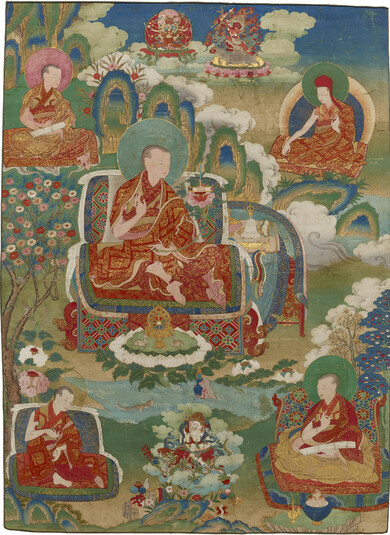
Item: Teacher (Lama) - Gorampa Sonam Sengge
| Origin Location | Tibet |
|---|---|
| Date Range | 1700 - 1799 |
| Lineages | Buddhist |
| Collection | Private |
Gorampa Sonam Sengge (1429-1489 [TBRC P1042]), the 6th Abbot of Ngor Monastery.
The monastic figure at the upper right side is Khedrub Palden Dorje (1411-1482 [P1037]), 5th Ngor Khenchen. At the upper left side is Gyaltsab Kunga Wangchug (1424-1478 [P1040]), 4th Ngor Khenchen. At the lower right is Yongdzin Konchog Pel (1445-1514 [P1873]), 7th Ngor Khenchen. At the lower left side Jetsun Sanggye Rinchen (1450-1524 [P1027]), 8th Ngor Khenchen. Each figure is accompanied by a name inscription.
At the top are the two meditational deities Manjuvajra Guhyasamaja and Rakta Yamari. "...Manjuvajra, with a body the colour of purified gold, three faces and six hands. The main face is yellow, the right blue and the left white. The first two hands embrace the Mother. The lower right hands hold a sword and arrow, and the lower left an utpala [flower] and bow; wearing jewel ornaments and having the thirty-two major and eighty minor marks; seated with the legs in the vajra posture. In the lap is the Mother Manjuvajra with three faces and six hands, with the colour, hand objects and embrace, the same as that of the Father. Both are resting in a state of union and emanating forth rays of light." (Written by Jamyang Khyentse Wangchug, 1524-1568).
"Rakta Yamari, [with] one face and two hands. The right [hand] holds aloft a white stick marked with a fresh yellow human head. The left holds a blood filled skullcup embracing the consort of self light. The face has bared fangs and a curled tongue [and] three round red eyes. Having yellow hair bristling upwards [and] a lower garment of tiger skin. Adorned with the eight great nagas, a necklace of fifty fresh heads and a crown of five dry skulls. Standing on a red buffalo in a manner with the left leg extended." (The One Hundred Methods of Accomplishment by Ngorchen Konchog Lhundrub (1497-1557), bibliographic information. Based on the Bari Gyatsa of Bari Lotsawa Rinchen Drag, 1040-1112 [P3731]).
At the bottom center is White Jambhala. White Jambhala Riding a Dragon is believed to come through the tradition of Jowo Atisha, founder of what came to be known as the Kadam School. This specific white form of Jambhala is also believed to be an emanation of Avalokiteshvara. The other forms of Jambhala, such as yellow and black, of are their own individual entity and not associated with Avalokiteshvara. The lineage of teachers for the White form of Jambhala lists Lokeshvara first fiollowed by Jowo Atisha. This is most likely an indication that the practice is a 'pure vision' creation of Atisha himself and not based on an Indian or Sanskrit source text.
Top left: Gyaltsab Kunga Wangchug (1424-1478 [P1040]), 4th Abbot Ngor. Top right: Khedrub Palden Dorje (1411-1482 [P1037]), 5th Abbot of Ngor. Center: Gorampa Sonam Sengge (1429-1489 [TBRC P1042]), 6th Abbot of Ngor. Bottom right: Yongdzin Konchog Pel (1445-1514 [P1873]), 7th Abbot of Ngor Bottom left: Jetsun Sanggye Rinchen (1450-1524 [P1027]), 8th Abbot of Ngor.
Jeff Watt, 2-2024

Collection: Christie's, New York, March, 2024 (Painting, Curator's Selection)
Collection: Christie's, New York, March, 2024 (Painting)
Teacher: Gorampa Sonam Sengge
